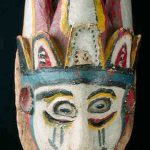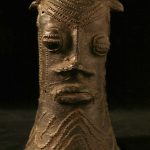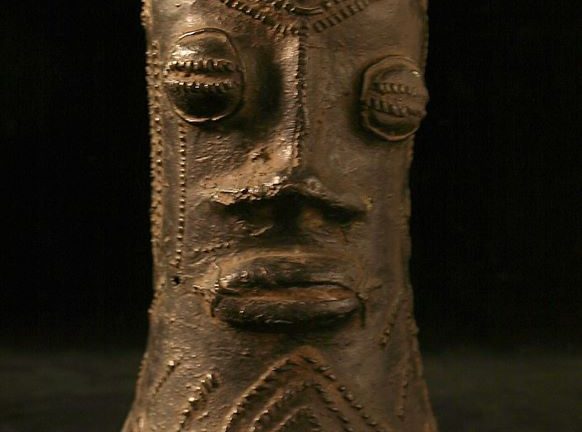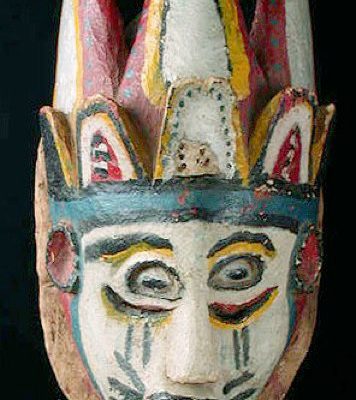Igala History: Áyẹ́gbà Ọma Ìdoko
The biography of Àtá Áyẹ́gbà Ọma Ìdoko is anchored on both oral and written claims by different sources. Oral history has it that his mother was called Ífùnányá and that she hailed from Énúgu Ezìkè, an Ìgbò community across the eastern border where, for over five hundred years, the Igala have had a commanding presence.
On his father’s side, he descended from the Àbùtù Ẹ̀jẹ̀ royal pedigree, from which Ágánápojè, his paternal grandfather, and Idoko, his own father, had taken turns to rule in the rotational Agatu diaspora monarchy which Àbùtù Ẹ̀jẹ̀, representing the Igala (leopard) group, had co-established with the Idoma and Alago components. According to Robert Arthur Sargent (1984), the three groups, along with the Etulo, Igbira, some Jukun and Hausa groups, had been members of the Kwararafa multi-ethnic confederacy, which had relocated from the Sudanic region to the Benue Basin, with its capital at Biepi. At about 1610 – 1640, Àbùtù Ẹ̀jẹ̀ contested for the Kwararafa throne, being ‘a legitimate contender,’ but he ‘saw his candidacy swept aside’ through a literal seizure of political power by the Jukun in favour of their candidate and his rival, Adi Agba Kenjo. Àbùtù Ẹ̀jẹ̀ responded to this injustice by cutting ties with the parent body, carrying with him his Igala group. Other groups, like the Idoma, Alago, Etulo, Igbira and even some Jukun and Hausa, joined him in solidarity and he led a migration comprising all of them out of Biepi.
Sargent also tells of the efforts of Igala-Kwararafa royalists in the ‘Agatu enclave,’ including Ayegba’s ancestors, in forestalling the oppression, coercion and economic exploitation of the indigenous populations by the Bini elite in the ‘Idah enclave,’ leading to the final abdication of the throne by the incumbent Bini dynasty rulers in 1687. That paved a way for Ayegba to ascend the throne through the popular support of the aboriginal Ígálámẹ̄la Clans, the Igbo and Aro settler communities. In fact, it is stated that Ìdoko, the father of Áyẹ́gbà, was on throne in the neigbouring Agatu monarchy, which his grandfather, Àbùtù Ẹ̀jẹ̀, had co-founded with other Kwararafa deserters, (the Igala, Idoma and Alago) and he became the first to rule in that monarchy as the Ata-in-diaspora.
The founding of the Agatu monarchy in 1627 – 1657 A.D. had posed a direct threat to the Bini dynasty, which had been in control of the overland and trans-Saharan trading systems, not to talk of the coastal overseas trade in Bini beads and cloth. The Igala-Kwararafa royalists moved en masse southwest of Agatu into the Ata’s domain. Upon arrival, unlike the Binis, the royalists intermarried with the local the Igala and Igbo populations on ground. Examples were the union between Ebuleejonu, the daughter of the Martyr of Agatu (Abutu Eje) and Aga Okpoluwali (the Achadu at Idah) and the marriage between Átíyẹ̀lẹ̀ with Agbaji in Ankpa that led to the establishment of the existing Ògwùchẹ́kwọ̀ royal dynasty.
Collaboration between the Igala-Kwararafa royalists and the local populations, including the Igbo and Aro-manatee against the high-handedness of the Bini invaders stifled the latter economically, leading to their sudden abdication of the throne by Agogshi and, later, by his son, Olema II in 1687 from throne they had seized way back in 1507.
The contact, interaction, inter-marriage and subsequent integration of the Igala-Kwararafa royalists with the native populations gave rise to a formidable force against the oppressive Bini dynasty. For instance, the Agatu royalists blocked the Bini merchants from using the northern entry point at Loko, where trade items – particularly, horses – from the core north, passed through to the popular Ejule market, which, in the previous generations, the Bini dynasty had developed to an international standard. In fact, they had set up a military outpost at Loko and Ejule to protect the market and the routes leading into it, against slave raiders that were then a national nuisance. Emboldened by the royalists’ support, the local chiefs to the east refused payment of tributary levies to the Bini dynasty and, instead, diverted same to the Agatu government.across the river. In addition, the Igbo traders, also victims of Bini dynasty’s polarisation, nepotism and exploitation, began to abandon Bini market-setups, preferring the Agatu exchange economy, which promised higher dividends and opportunities for the growth of their merchandize.
Starved of resources and, in desperation, Ata Agoshi`s administration decided to revive its southern slave trading system and attempted to seize and sell into slavery persons of Aro-manatee origin – the same Aro that had conspired with the Bini army to conquer Idah way back in 1507. This attempt proved fatal to the Bini dynasty as the entire population began to complain openly of their inhuman trade tactics and loss of credibility. Shamed and frustrated, Agoshi, threw in the towel and ran into exile at Doma, with his eyes on the salt deposit nearby. Olema II, besieged by a myriad of challenges, including a sound economic base, saw the wisdom in giving in to Áchádú Ùmẹ̀pà’s pressure to quit the throne. The Achadu had asked him to choose between his life and the throne; and he chose the former. Then, he fled Idah across the River Benue and joined his father, Agoshi, in exile at Doma in 1687, leaving a vacuum on the throne of Ata-Igala, which, through popular support, Ayegba honourably filled in the same year.
h Áyẹ́gbà, was a great grand-son of Àbùtù Ẹ̀jẹ̀, who had a daughter, Ebulejonu and a son, Agánapoje, the father of Idoko and Áyẹ́gbà’s direct paternal grand-father.
Àyẹ́gbà and his rise to power at Ida in 1687. As a transitional figure, he was a bridge between two epochs: the oppressive regime of the ruling Bini dynasty, on the one hand, and the prospective, third (or Kwararafan) dynasty, which he, Àyẹ́gbà, was destined to originate.
The period, 1627 – 1657, witnessed the gradual disintegration of the once-strong, monolithic Kwararafan multi-ethnic confederacy and how successor states emerged from its ashes at Idah, Ankpa, Domà, Kèánà Ádọká, Ùgbójù, Òtùkpó and Ètùló, among others. The period also experienced an influx of the Igala-Kwararafan royalists from Agatu area into the Ata’s territory and they interacted with the local population, resulting in inter-marriages, which fast-tracked their subsequent assimilation, acculturation and total integration. The strength derived from this cohesion was later weaponized into a political capital and the indigenes exert economic pressures on the Bini dynasty and eventually stifled it out of power “in the Idah enclave.” It also strengthened Prince Áyẹ́gbà Ọma Ìdoko to fill the vacuum left by Ata Olema II, the last Bini king to rule at Ida, by the former’s sudden abdication of the throne and flight into exile to join his father and predecessor, Agoshi.
Achievements
Ayegba, an administrative genius, started off with the adoption of the tested Kwararafan principles of justice and equity to guide his government. Determined to run an effective, popular and egalitarian regime, he first established a hereditary central bureaucracy, which involved every segment of the society and was acceptable to the majority of the population. The third dynasty appointed six (6) Officers of State and twelve Junior Councilors were also appointed.
Ayegba also conferred titles on his royal Eunuchs (personal retainers), who were collectively referred to as ‘Àmonójí.’ They “were familiar with the routine of the many religious rituals, which formed so vital a part of the Àtá’s daily life. In order to ensure that they were not far away from him, Áyégbà built and allocated official accommodation to his palace retainers called ‘Ókété’ (Quarters). The royal servants, ‘Àmedìbò Àtá,’ in the past, protected the Àtá’s person and harem, treasures, royal robes and regalia. They also mobilized workers to rehabilitate the physical structures in the palace, collected tributes, performed rituals for the Ata and served as intermediaries (Ọ̀híégba) between the King and the Provincial Chiefs (Àmonú) and their subjects.
Under the watch of Àtá Ayégbà, the following titles for the women from the Ata’s family ̣ – his sisters and wives – were created. These included “Íyegbàgá; Íyedàdú; Ákwūma-Àtá; Íye Ọ̀kpọ́kpọ̀nọ́kwúù; Ómiya-Ína; and Ómiya kélé.”
Turning his attention to the interior, he created the position of ‘Ónu’ (Chief) for each of the outlying nineteen districts in the Ígálá Kingdom. Actually, he sent forth “his relatives and ‘tried’ followers to carve out fiefs for themselves and their heirs, granting them what amounted to a complete delegation of authority… The fiefs became, in fact, microcosms of the Igala Chiefdom, the fief-holder (Ónú) receiving a title and an official “salutation” from the Àtá, together with a gift of bead bracelets which were – as they are today – the outward and visible sign of his authority.” Àmonú (Chiefs), like the King (Àtá) himself, are priest-kings replicating the spiritual and secular duties of the king. These include:
- Observance of traditional festivals and related events;
- Collection and remitting of taxes;
- Adjudication of minor disputes;
- Award of titles at ward or clan levels;
- Collection of tributes for transmission to Ídá through designated aides (see Ọ̀híégba).
The ‘Ónú’ title is hereditary and remains non-functional until it is energized by the Ata’s conferment of it on the claimant and is given his paraphernalia of office. Each Ónú has a Council of Elders with assigned roles and responsibilities; and these assist him in his day-to-day administrative duties. He also “…receives from his people tithes of farm and sylvan produce and tributes of game…His powers are absolute except for death sentences, which with few exceptions, were referred to the Ata.”
Áyẹ́gba, thereafter, shifted his focus to territorial expansion of his kingdom, ̣ using his own military prowess, diplomacy and astuteness. He also relied on the conquests of Ọ́nó ̣jáà Òbòní, one his major contemporaries. Ọ́nọ́jáà Òbòni was a dreaded super-giant with six fingers and six toes who raided surrounding territories and annexed them to the Ata’s dominions.
According to Clifford, “By the close of the 18th Century, Igala had developed into a large and powerful state and had, in all probability, reached its zenith…The eastern boundary of Igala proper ran from River Ocheku through Agatu, Ocheku, Adoka, Boju, through the Idoma and Nsukka countries to Damoogoo (Àdàmàgwú, now extinct) on the Niger, some little way above Onitsha. To this must be added the external fiefs of Igbo, Panda, Igu (Koton Karifi) and Ishabe (Kakanda); whilst the Ata’s writ on the Niger itself extended to the Bussa rapids where Mungo Park met his death.”
The adoption of the Kwararafan principles and the establishment of a bond between the royal house and the commoner population, through the bonding system involving patronage titles, appointments, marriage gifts to prominent individuals and the incorporation of every segment of the society into the political, cultural, social and economic well-being of the state.
In anticipation of loyalty and devotion to the state, the third dynasty adopted the concept of political and economic patronage, which brought out the best in recipients of such patronage and encouraged the legitimization of his administration.
For purposes of security and revenue on the Niger and Benue Rivers, the third dynasty, under Ayegba’s watch, appointed Waterside Chiefs to man the downstream, upstream and domestic sectors of the rivers as follows:
- Àgàídoko Clan to produce the Chief that oversees all
matters on the downstream sector of the River Niger.
- The Àbọkọ̀ Clan to oversee matters in the upstream
sector of the River Niger, including the River Benue;
and
- The Ọ́mọgbàjẹ Clan who control the Waterside area of
the capital enclave, and was known as the Waterside
Chief.
The appointed hereditary officials in the administration of the rivers were vested with the following responsibilities:
- Control and taxation of movement of goods on the rivers and remittance of revenue to the Ata;
- Safeguarding peace along the Niger and Benue to ensure safety of traffic;
- Provision of canoes for the Ata’s commercial transactions and to transport the Ata’s produce to suitable markets on the Niger;
- Acting as intermediaries between the central monarchy and foreigners on the river, desiring audience with the king, as happened during the three consecutive visits of the members of the first, second and third British Expeditions in 1832; 1841 and 1854 respectively.
- Provision of economic support to the palace;
- Organisation of markets and the general good conduct of commerce and commercial officers.
- The establishment of a number of clans as purveyors to the royal house, including the Ègùalá and Ádọkpúlú clans who are responsible for the royal burial grounds.
- The creation of an office for Adenyi Clan, the supplier of the royal shoes.
- The creation of the Átẹ́ẹbọ clan as guardians of the royal staff, called Òtutubátu.
- The appointment of the Ídúù-Òkólíko Clan was appointed as custodians of the shrine dedicated to the nature spirits.
- The creation of Òhínā Clan which provided the royal diviners.
- The appointment of a large number of citizens and residents and installation of a number of clan-heads as hereditary leaders of specific craft, specialized services, ritual leaders and officials whose positions were hereditary.
- The creation of “a mechanism for involving large numbers in the actual administration of the state.”
Robert Arthur Sargent lists out the factors that were responsible for the success of Ata Ayegba’s administration, namely:
- The evolution of a socio-cultural and political integration of the diverse population through the establishment of seamless linkages between them in order to enable a centralized structure;
- The development of the social formation and a national trading formation that would comprise the sub-chiefdoms of Ankpa and Dekina divisions, as a unified whole, contrary to the fragmented entity that it was during the long years of Bini dynastic rule;
- The introduction of tribute-paying as part of “economic support for the central elite without seeming to employ coercive and exploitative tactics,” as did the out-gone Bini dynasty; and
- The expansion of overseas trade through the coastal ports, which made the eighteenth century an important period in the economic development of Ida under the third dynasty.
The twilight of Áyégbà’s reign witnessed increasing ̣inclination towards his spiritual duties. He stated further that officials were increasing both “…in numbers and in arrogance, such that in the course of time, there was no longer access to the Ata, even to his Councilors, save through them. He became in the course of time… a Pope and his compound a Vatican from which he was only encouraged to emerge for essential ritual performances, to which none but the chosen could attend.” According to Miles and Boston, Áyégbà ̣ might have joined his ancestors about 1717A.D.
Yesufu Etu states that ‘Áyẹ́gbà died in his sleep.’ He stated further that “In the whole of Igalaland, he is perceived as a larger-than-life personality who is generally appreciated by Igalas for his selflessness, particularly, in the reversal of Igala status from a vassal state to an Independent sovereign state in the course of which he made painful personal sacrifices, sacrificing three of his daughters and marrying one off to the Nupe Mallam that helped win the Igala-Jukun War and lasting peace for his kingdom.“
The immediate past Àtá-Igáláà, Dr. Àlíyù Óbàje, echoed the collective perception of his subjects of Àtá ̣ Ayègbà Ọma Ìdoko in 1988, when he referred to him as “Áyẹ́gbà the Great,” explaining that “Ayegba did good things, even though he had no modern education… The pattern of his administrative set-up was just copied by the late colonial Administrative Officers who came in 1900 AD.”
Miles Clifford comments that “…In the long line of Atas that followed, he stands alone.”dyna







